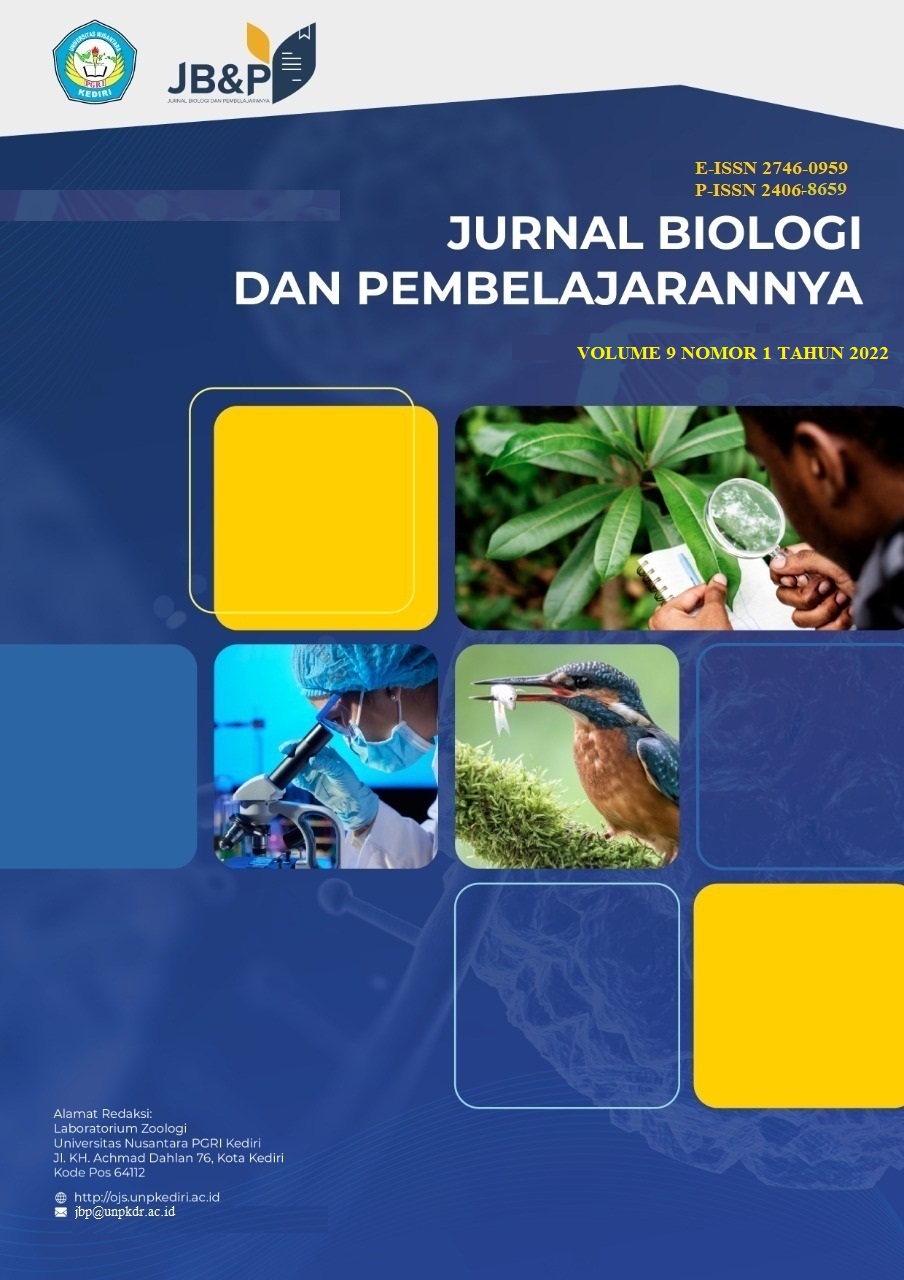Efektivitas Pembelajaran Science Environment Technology and Society pada Materi Sistem Kardiovaskular di Tingkat Sarjana
DOI:
https://doi.org/10.29407/jbp.v9i1.18037Keywords:
SETS, Critical Thinking SkillsAbstract
The weakness of online learning in human anatomy and physiology courses is that the expected final ability cannot be achieved which has an impact on the quality of learning that is less and less than optimal output. There needs to be a learning process in which there is the use of integrated learning media, innovative learning approaches, one of which is the approach of science, environment, technology, and society. The purpose of this study was to determine the effect of learning SETS integrated with learning media on students' critical thinking skills. The research method used a quasi-experimental design with a pretest-posttest non-equivalent control group design. The results of the study showed that there was an effect of learning SETS integrated learning media on students' thinking skills with a significance value of anaova test of 0.00. The conclusion of this study is that there is a positive influence between the use of SETS learning integrated with learning media on students' critical thinking skills.
References
Chee, S., Tunku, C., Rahman, A., Phaik, C., Cheah, K., & Rahman College, T. A. (2009). Teacher Perceptions of Critical Thinking Among Students and its Influence on Higher Education. International Journal of Teaching and Learning in Higher Education, 20(2), 198–206. http://www.isetl.org/ijtlhe/
Firdaus, F. Z., Suryanti, S., & Azizah, U. (2020). Pengembangan Multimedia Interaktif Berbasis Pendekatan SETS Untuk Meningkatkan Kemampuan Berpikir Kritis Siswa Sekolah Dasar. Jurnal Basicedu, 4(3), 681–689. https://doi.org/10.31004/basicedu.v4i3.417
Hayati, I. A., Rosana, D., & Sukardiyono, S. (2019). Pengembangan modul potensi lokal berbasis SETS untuk meningkatkan keterampilan proses IPA Development of SETS based local potential modules to improve science process skills. Jurnal Inovasi Pendidikan IPA, 5(2), 248–257. https://journal.uny.ac.id/index.php/jipi/article/view/27519/13402
Hidayati, N., & Irmawati, F. (2019). Developing digital multimedia of human anatomy and physiology material based on STEM education. JPBI (Jurnal Pendidikan Biologi Indonesia), 5(3), 497–510. https://doi.org/10.22219/jpbi.v5i3.8584
Hidayati, N., & Irmawati, F. (2020a). A Survey on the SETS-Based Human Anatomy and Physiology Course : Analysis of Instruments for Assesing Critical Thinking Skills Using Multimedia. International Forum of Life Science and Education. https://jurnal.uns.ac.id/prosbi/article/view/54048
Hidayati, N., & Irmawati, F. (2020b). Developing of science environment technology and society based on multimedia in human anatomy physiology learning. JPBIO (Jurnal Pendidikan Biologi), 5(2), 223–233. https://doi.org/10.31932/jpbio.v5i2.877
Hidayati, N., Irmawati, F., & Prayitno, T. A. (2019). Peningkatan Keterampilan Berpikir Kritis Mahasiswa Biologi Melalui Multimedia STEM Education. JPBIO (Jurnal Pendidikan Biologi), 4(2), 84–92. https://doi.org/10.31932/jpbio.v4i2.536
Hidayati, N., Pangestuti, A. A., & Prayitno, T. A. (2019). Edmodo mobile: developing e-module biology cell for online learning community. Biosfer, 12(1), 94–108. https://doi.org/10.21009/biosferjpb.v12n1.94-108
Khasanah, N. (2015). SETS (science, environmental, technology and society) sebagai pendekatan pembelajaran IPA modern pada kurikulum 2013. Seminar Nasional Konservasi Dan Pemanfaatan Sumber Daya Alam 2015, 270–277. https://media.neliti.com/media/publications/170173-ID-sets-science-environmental-technology-an.pdf
Khusnah, L., Ibrohim, & Ghofur, A. (2015). Pengembangan Perangkat Pembelajaran IPA Terpadu Berbasis Salingtemas dan Inkuiri Terbimbing untuk Membentuk Pemahaman Terintegrasi Peserta Didik SMP. Jurnal Pendidikan Sains, 3(4), 149–157. http://journal.um.ac.id/index.php/jps/article/view/8125/3698
Maimunah, M. (2016). Penggunaan Model Pembelajaran Science Environment Technology and Society (Sets) untuk Meningkatkan Kemampuan Berpikir Kritis dan Sikap Ilmiah. Formatif: Jurnal Ilmiah Pendidikan MIPA, 6(2), 134–140. https://doi.org/10.30998/formatif.v6i2.947
Minarti, I. B., Susilowati, S. M. E., & Indriyanti, D. R. (2012). Perangkat Pembelajaran IPA Terpadu Bervisi SETS Berbasis Edutainment pada Tema Pencernaam. Journal of Innovative Science Education, 1(2). https://journal.unnes.ac.id/sju/index.php/jise/article/download/632/618
Nisak, M. K., Wartono, W., & Suwono, H. (2017). Pengaruh pembelajaran guided inquiry berbasis salingtemas terhadap keterampilan berpikir kritis siswa SMP berdasarkan kemampuan akademik. Jurnal Pendidikan: Teori, Penelitian, Dan Pengembangan, 2(1), 113–120. http://journal.um.ac.id/index.php/jptpp/article/view/8470
Prayitno, T. A., & Hidayati, N. (2020). Multimedia development based on science technology engineering and mathematics in microbiology learning. JPBIO (Jurnal Pendidikan Biologi), 5(2), 234–247. https://doi.org/10.31932/jpbio.v5i2.879
Sugiyono. (2011). prof. dr. sugiyono, metode penelitian kuantitatif kualitatif dan r&d. intro ( PDFDrive ).pdf. In Alfabeta. Alfabeta Bandung. https://www.pdfdrive.com/prof-dr-sugiyono-metode-penelitian-kuantitatif-kualitatif-dan-rd-intro-d56379944.html
Suriyanto, & Alinata, S. R. (2016). Penerapan Pendekatan Salingtemas Untuk Meningkatkan Prestasi Belajar Kimia. Jurnal Inovasi Pendidikan Kimia, 9(1). http://journal.unnes.ac.id/nju/index.php/JIPK/article/view/4809/3977
Tamimiya, K. T., Gani, A. A., & Putra, P. D. A. (2017). Pengembangan Modul Pembelajaran IPA Berbasis SETS untuk Meningkatkan Collaborative Problem Solving Siswa SMP Pada Pokok Bahasan Cahaya. Jurnal Pembelajaran Fisika, 5(2), 392–398. https://jurnal.unej.ac.id/index.php/JPF/article/view/4344
Walid, A., Sajidan, S., Ramli, M., & Kusumah, R. G. T. (2019). Construction of the assessment concept to measure students’ high order thinking skills. Journal for the Education of Gifted Young Scientists, 7(2), 237–251. https://doi.org/10.17478/jegys.528180
Yulistiana, Y. (2015). Penelitian Pembelajaran Berbasis SETS (Science, Environment, Technology, And Society) dalam Pendidikan Sains. Formatif: Jurnal Ilmiah Pendidikan MIPA, 5(1), 76–82. https://doi.org/10.30998/formatif.v5i1.169
Downloads
Published
Issue
Section
License
Authors who publish with this journal agree to the following terms:
- Copyright on any article is retained by the author(s).
- The author grants the journal, right of first publication with the work simultaneously licensed under a Creative Commons Attribution License that allows others to share the work with an acknowledgment of the work’s authorship and initial publication in this journal.
- Authors are able to enter into separate, additional contractual arrangements for the non-exclusive distribution of the journal’s published version of the work (e.g., post it to an institutional repository or publish it in a book), with an acknowledgment of its initial publication in this journal.
- Authors are permitted and encouraged to post their work online (e.g., in institutional repositories or on their website) prior to and during the submission process, as it can lead to productive exchanges, as well as earlier and greater citation of published work.
- The article and any associated published material is distributed under the Creative Commons Attribution-ShareAlike 4.0 International License













